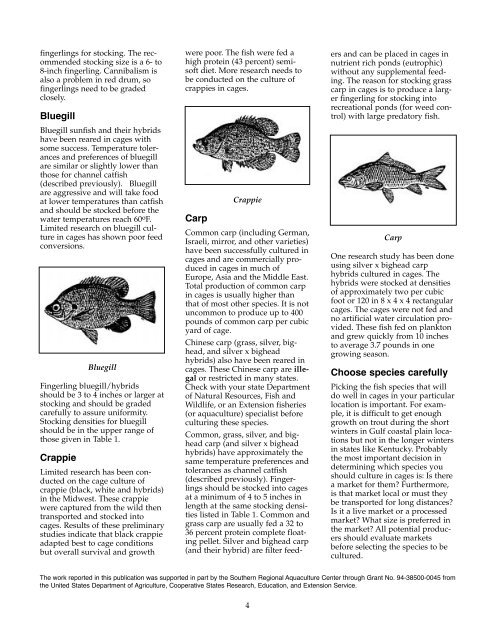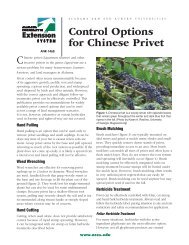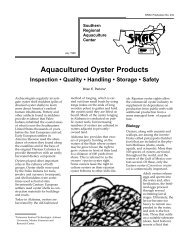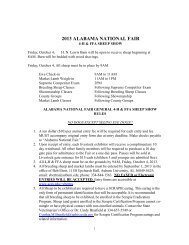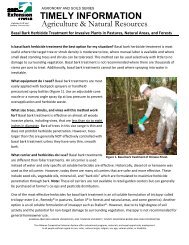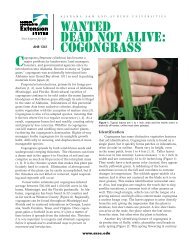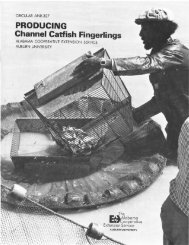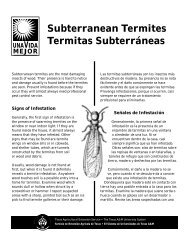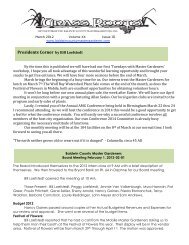Cage Culture: Species Suitable for Cage Culture - SRAC Fact Sheets
Cage Culture: Species Suitable for Cage Culture - SRAC Fact Sheets
Cage Culture: Species Suitable for Cage Culture - SRAC Fact Sheets
You also want an ePaper? Increase the reach of your titles
YUMPU automatically turns print PDFs into web optimized ePapers that Google loves.
fingerlings <strong>for</strong> stocking. The recommended<br />
stocking size is a 6- to<br />
8-inch fingerling. Cannibalism is<br />
also a problem in red drum, so<br />
fingerlings need to be graded<br />
closely.<br />
Bluegill<br />
Bluegill sunfish and their hybrids<br />
have been reared in cages with<br />
some success. Temperature tolerances<br />
and preferences of bluegill<br />
are similar or slightly lower than<br />
those <strong>for</strong> channel catfish<br />
(described previously). Bluegill<br />
are aggressive and will take food<br />
at lower temperatures than catfish<br />
and should be stocked be<strong>for</strong>e the<br />
water temperatures reach 60 o F.<br />
Limited research on bluegill culture<br />
in cages has shown poor feed<br />
conversions.<br />
Bluegill<br />
Fingerling bluegill/hybrids<br />
should be 3 to 4 inches or larger at<br />
stocking and should be graded<br />
carefully to assure uni<strong>for</strong>mity.<br />
Stocking densities <strong>for</strong> bluegill<br />
should be in the upper range of<br />
those given in Table 1.<br />
Crappie<br />
Limited research has been conducted<br />
on the cage culture of<br />
crappie (black, white and hybrids)<br />
in the Midwest. These crappie<br />
were captured from the wild then<br />
transported and stocked into<br />
cages. Results of these preliminary<br />
studies indicate that black crappie<br />
adapted best to cage conditions<br />
but overall survival and growth<br />
were poor. The fish were fed a<br />
high protein (43 percent) semisoft<br />
diet. More research needs to<br />
be conducted on the culture of<br />
crappies in cages.<br />
Carp<br />
Crappie<br />
Common carp (including German,<br />
Israeli, mirror, and other varieties)<br />
have been successfully cultured in<br />
cages and are commercially produced<br />
in cages in much of<br />
Europe, Asia and the Middle East.<br />
Total production of common carp<br />
in cages is usually higher than<br />
that of most other species. It is not<br />
uncommon to produce up to 400<br />
pounds of common carp per cubic<br />
yard of cage.<br />
Chinese carp (grass, silver, bighead,<br />
and silver x bighead<br />
hybrids) also have been reared in<br />
cages. These Chinese carp are illegal<br />
or restricted in many states.<br />
Check with your state Department<br />
of Natural Resources, Fish and<br />
Wildlife, or an Extension fisheries<br />
(or aquaculture) specialist be<strong>for</strong>e<br />
culturing these species.<br />
Common, grass, silver, and bighead<br />
carp (and silver x bighead<br />
hybrids) have approximately the<br />
same temperature preferences and<br />
tolerances as channel catfish<br />
(described previously). Fingerlings<br />
should be stocked into cages<br />
at a minimum of 4 to 5 inches in<br />
length at the same stocking densities<br />
listed in Table 1. Common and<br />
grass carp are usually fed a 32 to<br />
36 percent protein complete floating<br />
pellet. Silver and bighead carp<br />
(and their hybrid) are filter feed-<br />
4<br />
ers and can be placed in cages in<br />
nutrient rich ponds (eutrophic)<br />
without any supplemental feeding.<br />
The reason <strong>for</strong> stocking grass<br />
carp in cages is to produce a larger<br />
fingerling <strong>for</strong> stocking into<br />
recreational ponds (<strong>for</strong> weed control)<br />
with large predatory fish.<br />
Carp<br />
One research study has been done<br />
using silver x bighead carp<br />
hybrids cultured in cages. The<br />
hybrids were stocked at densities<br />
of approximately two per cubic<br />
foot or 120 in 8 x 4 x 4 rectangular<br />
cages. The cages were not fed and<br />
no artificial water circulation provided.<br />
These fish fed on plankton<br />
and grew quickly from 10 inches<br />
to average 3.7 pounds in one<br />
growing season.<br />
Choose species carefully<br />
Picking the fish species that will<br />
do well in cages in your particular<br />
location is important. For example,<br />
it is difficult to get enough<br />
growth on trout during the short<br />
winters in Gulf coastal plain locations<br />
but not in the longer winters<br />
in states like Kentucky. Probably<br />
the most important decision in<br />
determining which species you<br />
should culture in cages is: Is there<br />
a market <strong>for</strong> them? Furthermore,<br />
is that market local or must they<br />
be transported <strong>for</strong> long distances?<br />
Is it a live market or a processed<br />
market? What size is preferred in<br />
the market? All potential producers<br />
should evaluate markets<br />
be<strong>for</strong>e selecting the species to be<br />
cultured.<br />
The work reported in this publication was supported in part by the Southern Regional Aquaculture Center through Grant No. 94-38500-0045 from<br />
the United States Department of Agriculture, Cooperative States Research, Education, and Extension Service.


